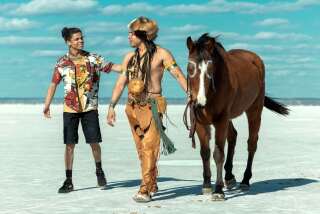Japanese woodcuts, sci-fi flicks, anime and an eye for detail all go into ‘Isle of Dogs’
“Isle of Dogs” is a beloved mutt.
On the surface, it’s a halting, heart-touching story of a boy and his dog (and another, rougher dog learning to love, and a human pro-dog activist versus anti-dog meanies). It has the hallmarks of director and co-writer Wes Anderson’s live-action work transferred to stop-motion-animated dogs living on a gigantic pile of garbage. But peel away those layers and you get … 18th century Japanese woodcuts, 1960s science-fiction movies, anime, stillness and more.
Co-production designer Paul Harrod said that by the time he arrived to the team, one of the key references Anderson and co-production designer Adam Stockhausen had established was “the Edo-era ukiyo-e illustrations by people like Hokusai and Hiroshige.” Harrod noted the irony of using these placid depictions of landscapes and waves, “considering the film essentially takes place on a trash heap. We had to apply a different set of textures. For that, we turned to a couple of photographers: Edward Burtynsky [known for industrial landscapes] and Chris Jordan,” whose works depict industrial waste products on a massive scale.
In “Isle,” which was released in April, dogs are banned from Megasaki City and banished to Trash Island, home of a defunct “animal-testing plant,” as the filmmakers put it. A young boy, Atari (voiced by Koyu Rankin), goes there to find his dog, Spots (Liev Schreiber). He meets tough dog Chief (Bryan Cranston) and others, with dogcatchers and a lethal robot en route to eliminate the supposed canine threat.
“Our general approach was to look at it through the lens of the early-mid 1960s and to imagine what the world would look like, 20 years in the future, as seen from that point,” Harrod said. “Some of the Japanese science-fiction films of the 1960s that were directed by Ishirō Honda [known for Godzilla movies] — even though they’re space adventures, sometimes, when you’re on Earth, it still looks kind of like contemporary Japan of that period. People are driving around in Toyota sedans.”
Cinematographer Tristan Oliver said Anderson sent him “a watch list of maybe 40 Japanese movies from the ’60s and ’70s. … From this distance, they sort of meld into one, which is what we were after: A distillation of that feel.”

As expressed in “The Grand Budapest Hotel,” Anderson has evolved from a teller of small, intimate stories to a filmmaker who can maintain the personal over a much larger, intricately detailed canvas.
“His look is very much an illustrative form,” Oliver said. “Normally the cutting and directing are pointing your eye to a specific point in the frame. For Wes, it’s really as much about the edges. He’s carving the back of the statue even though the statue’s in the corner.”
Despite some complaints of racial stereotyping in the film, Oliver said Anderson manages a kind of alchemy between form and substance.
“I think the great skill of the movie is how the dialogue works with the picture,” he said. “Because you have this highly formalized environment and yet the chatty, throwaway style of the dialogue is actually what relieves that high form you’re looking at. A lot of the dialogue is very witty — the chats the dogs have, especially the dog who loves gossip. They’re in dire straits but they can still chat on like a group of old ladies.
“The key shot is when Atari cuddles Chief. The dog does a look to the camera that says, ‘What the hell is this?’ But immediately, that bond is formed.”
FULL COVERAGE: Get the latest on awards season from The Envelope »
Lead animator Jason Stalman said Anderson referenced anime legend Hayao Miyazaki, but perhaps not as one might expect.
“‘Spirited Away’ and ‘Howl’s Moving Castle’ — he especially referred to the peace and stillness in those beautifully composed shots. That was going to be a wonderful challenge for a stop-motion puppet animator, to have these moments but to keep the character alive,” he said.
“You have to manipulate these puppets with their little eyes and fur frame-by-frame and find a way, in the stillness, to not just let them look like a dead puppet.”
Stalman and Anderson shot live-action references of themselves acting out scenes to the actors’ recorded dialogue. Stalman would meld those visuals and the vocal performances to try to approximate, for instance, “Tilda Swinton’s emotional transitions” or “Bill Murray — he doesn’t do much, right? He has a spark of naughtiness in his eyes.”
Stalman said Anderson would extend shots, add frames, even ignore established cinematic geography to get the effects he wanted.
“You can’t be precious; you have to roll with those punches. It seems kind of scary at the time, but when you see it in the end, you go, ‘Oh my God, he was right.’”
Perhaps one way to understand the level of detail that went into the film is to reconsider the title. Oliver said Anderson referenced the actual “Isle of Dogs” (not an island, but an area in central London). If one were to ignore geography and ask such a filmmaker why he’d put so much effort into this film, he or she might respond, “I love dogs.”
More to Read
From the Oscars to the Emmys.
Get the Envelope newsletter for exclusive awards season coverage, behind-the-scenes stories from the Envelope podcast and columnist Glenn Whipp’s must-read analysis.
You may occasionally receive promotional content from the Los Angeles Times.






